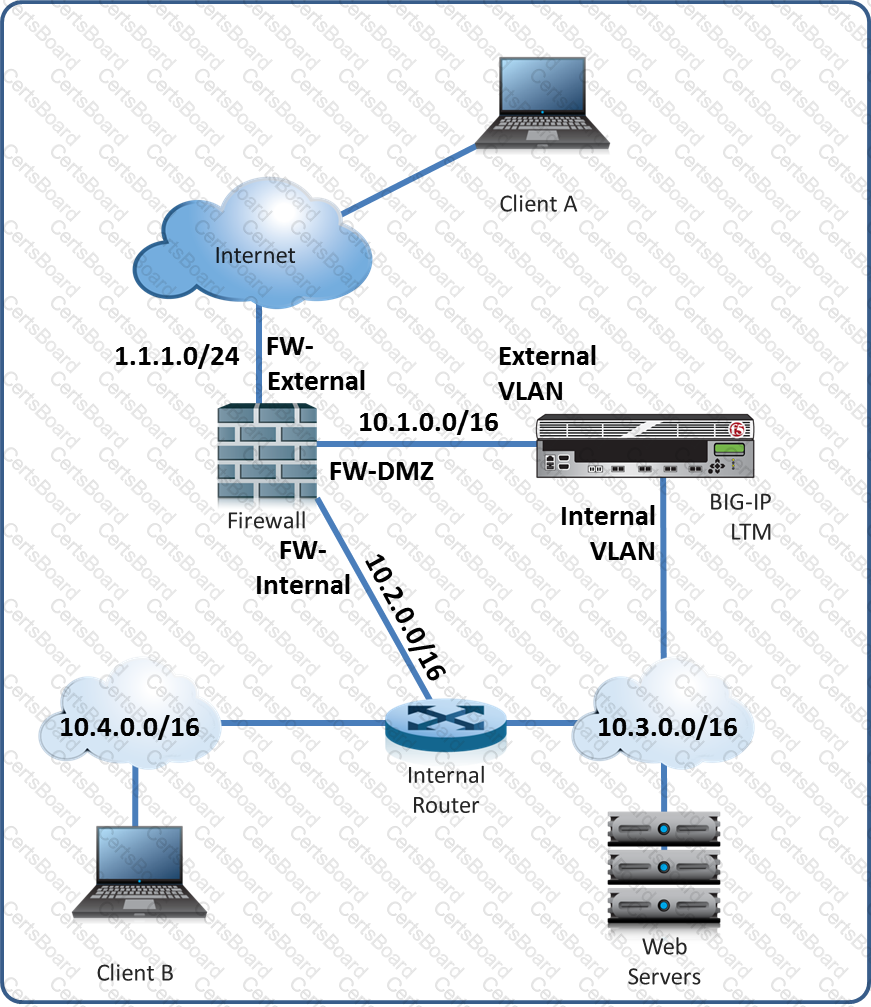The pool members are serving up simple static web content.
The current virtual server configuration is given as follows:
tmsh list ltm virtual simple
ltm virtual simple {
destination 10.10.10.10:80
ip-protocol tcp
mask 255.255.255.255
profiles {
http { }
httpcompression { }
oneconnect { }
tcp { }
}
snat automap
vlans-disabled
}
tmsh list ltm pool simple_pool
ltm pool simple_pool {
members {
10.10.10.11:80 {
address 10.10.10.11 }
10.10.10.12:80 {
address 10.10.10.12 }
10.10.10.12:80 {
address 10.10.10.13 }
}
}
Which three objects in the virtual server configuration can be removed without disrupting functionality of the virtual server? (Choose three.)
Which command line interface command will check if the BIG-IP platform contains a packet velocity ASIC (PVA)?
An LTM device is monitoring three pool members. One pool member is being marked down.
What should the LTM Specialist enable to prevent the server from being flooded with connections once its monitor determines it is up?
-- Exhibit –

-- Exhibit --
Refer to the exhibit.
A layer 2 nPath routing configuration has been deployed. A packet capture contains a client connection packet with the following properties:
Source IP:
Destination IP:
At which two locations could the packet capture have been taken? (Choose two.)
An LTM Specialist is troubleshooting virtual server 10.0.0.1:443 residing on VLAN vlan301. The web application is accessed via www.example.com. The LTM Specialist wants to save a packet capture with complete decrypted payload for external analysis.
Which command should the LTM Specialist execute on the LTM device command line interface?
A web application is meant to log the URI of the resource that responded to the client's initial Request-URI.
Which HTTP header will supply this information?
An IT administrator wants to log which server is being load balanced to by a user with IP address 10.10.10.25.
Which iRule should the LTM Specialist use to fulfill the request?
An LTM Specialist is tasked with ensuring that the syslogs for the LTM device are sent to a remote syslog server.
The following is an extract from the config file detailing the node and monitor that the LTM device is using for the
remote syslog server:
monitor
Syslog_15002 {
defaults from udp
dest *:15002
}
node 91.223.45.231 {
monitor Syslog_15002
screen RemoteSYSLOG
}
There seem to be problems communicating with the remote syslog server. However, the pool monitor shows that the remote server is up.
The network department has confirmed that there are no firewall rules or networking issues preventing the LTM device from
communicating with the syslog server. The department responsible for the remote syslog server indicates that there may
be problems with the syslog server. The LTM Specialist checks the BIG-IP LTM logs for errors relating to the remote syslog
server. None are found. The LTM Specialist does a tcpdump:
tcpdump -nn port 15002, with the following results:
21:28:36.395543 IP 192.168.100.100.44772 > 91.223.45.231.15002: UDP, length 19
21:28:36.429073 IP 192.168.100.100.39499 > 91.223.45.231.15002: UDP, length 169
21:28:36.430714 IP 192.168.100.100.39499 > 91.223.45.231.15002: UDP, length 181
21:28:36.840524 IP 192.168.100.100.39499 > 91.223.45.231.15002: UDP, length 169
21:28:36.846547 IP 192.168.100.100.39499 > 91.223.45.231.15002: UDP, length 181
21:28:39.886343 IP 192.168.100.100.39499 > 91.223.45.231.15002: UDP, length 144
NotE. 192.168.100.100 is the self IP of the LTM device.
Why are there no errors for the remote syslog server in the log files?
An LTM Specialist is troubleshooting a problem on an eCommerce website. The user browses the online store using port 80, adding items to the shopping cart. The user then clicks the "Checkout" button on the site, which redirects the user to port 443 for the checkout process. Suddenly, the user's shopping cart is shown as empty. The shopping cart data is stored in memory on the server, and the default source address persistence profile is used on both virtual servers.
How should the LTM Specialist resolve this issue?


